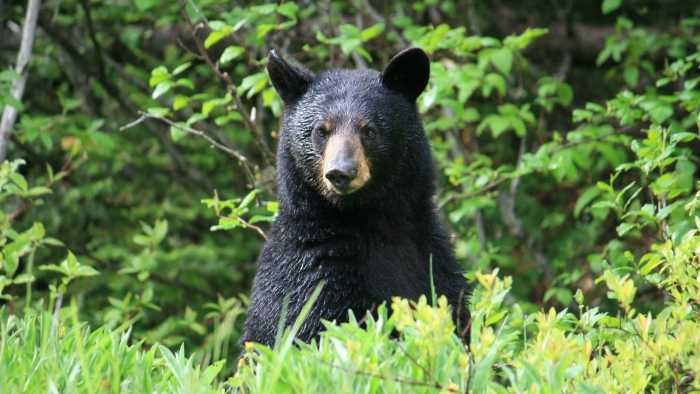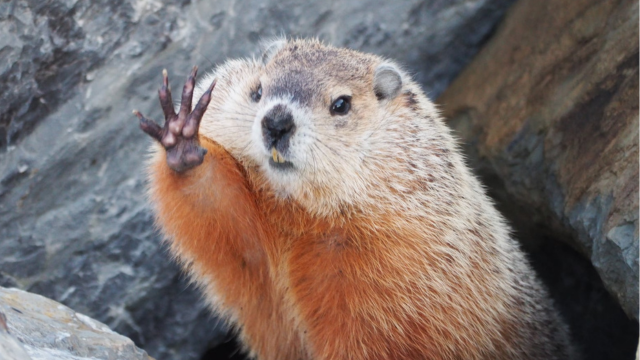
Feeding wildlife is illegal.
Wildlife safety
Forillon National Park
If you witness illegal activity in the park, such as feeding or harassing wildlife, call Parks Canada's dispatch service at 1-888-762-1422 (open 24 hours a day).Report illegal activities
A park that is mostly forest
Forillon National Park is almost entirely covered by forest. The wildlife in the park includes moose, black bears, coyotes and lynx.
Hikers may encounter one of these forest mammals on a trail, near a campsite, in the backcountry or around a pond.
Most encounters between humans and animals go well, for both parties. They even become fun travel stories. It is important that visitors inform themselves of certain safety practices from various park wildlife representatives to ensure proper cohabitation between humans and animals in the park.
The moose: King of our forests
Animal introduction

Moose can be solitary and social animals.
Photo: Norbert Denis
The moose (Alces Americanus) is one of the animals that sparks the most interest. The male’s imposing stature and impressive antlers earned it the nickname “king of the forest.” It is the largest land mammal that lives in Forillon.
It was less present on the Forillon territory before the 1920s and at low density until the 1970s, but moose have increased in number since the park was created. Based on the data from the 2023 aerial survey, the park’s moose population is estimated at around 520 total, or 22 moose/10 km2.
With a little luck, some knowledge of their habits, some patience and a lot of caution, it is possible to see moose in the park. It is recommended that people maintain a minimum distance of 50 m from a moose.
Although relatively calm and mostly solitary, moose can be territorial and social during the mating season, mainly from mid-September to early October. Hikers in the park are advised to exercise more caution during this period.
Moose behaviour
Moose, like most ungulates, are generally peaceful.
Unlike black bears, their signals can be harder for humans to decode. Here are a few clues to help you “predict” their behaviour and know how to react.
A moose may show agitation or aggression during the mating season or in a vulnerable situation (in reaction to an attack, if cornered, disoriented, wounded or ill).
Humans can instinctively detect an aggressive moose. Head tilted forward, ears folded back, the moose will face what it sees as a threat, emitting guttural sounds or bellows, the hairs on its spine standing up, pawing with one of its front legs, ready to charge.
No moose attacks on humans have ever been recorded in the park.
Sharing the land with the moose
Moose are at home in the forest. Always show respect for the moose and its environment. Never approach a moose, never try to make it react, never call it by imitating its bellow and, above all, never attack it.
What to do if a moose charges at you:
- Stay calm.
- Do not run.
- Get behind a large tree or group of trees, without losing sight of the moose. The tree will protect you.
- Show the moose that you are not afraid by speaking loud. As soon as it recognizes that you are not a threat, it will leave.
- Wait until it gets to a safe distance (around 50 m) before turning back.
- Breathe, take a sip of water, regain your composure.
- Call someone who can reassure you.
- Call the Parks Canada emergency dispatch at 1-888-762-1422 to report the situation.
Our conservation efforts
Moose are large herbivores, consuming 20 to 30 kg of vegetation per day.
Over the last two decades, the moose population in Forillon has grown exponentially, reaching densities that could threaten the park’s ecological integrity.
This is why we developed the Hyperabundant Moose Management Plan.
Additional informations

White-tailed deer are three to four times smaller than moose.
The white-tailed deer is another type of deer that lives in the park. It is smaller and much more fearful of humans. If you are lucky enough to spot one, enjoy the moment by keeping a minimum distance of 50 m.
For more information, visit our page Moose - Maintaining forest balance
Do you have questions about wildlife safety in the park? Ask any guide-interpreter or park warden you meet.
The black bear: Calming our fears
Animal introduction

The black bear’s diet consists mainly of plants.
Photo: Mathieu Dupuis
Revered in some cultures, misunderstood in others, the black bear is a forest mammal that fears humans. It is also an opportunistic, powerful and solitary animal.
Endemic to Canada, the black bear is the only member of the ursid family to be found in Forillon. It is also the smallest.
The black bear population within the park is estimated at about 130 bears.
There are certain signs of black bears in the park. Attentive hikers might find an ant nest scraped from the surface, claw marks from the bottom to the top of a poplar, shreds of bark at the bottom of certain conifers such as cedars, or scat on parts of a trail.
The black bear’s diet consists almost exclusively of plants and fruit.
Sharing the land with the black bear
No bear attacks on humans have ever been recorded in the park.
A better understanding of the black bear can help hikers overcome some of their fears when walking in the forest. Learn what to do in case you encounter a black bear.
For more information, visit our webpage Sharing the land with black bear
Our conservation efforts
Counting black bears in Forillon is no easy task for our conservation team. Black bears hide in dens during the long winter months and are active the rest of the year in Forillon’s dense forest, avoiding contact with humans.
The installation of self-triggering surveillance cameras (hunting cameras) placed randomly around the territory has been a reliable solution for assessing the park’s bear population. Thanks to this technique, our team estimated that in 2020, Forillon was home to around 130 black bears.
The black bear population in both Forillon and Canada is healthy.
Related links

Black bears stand on their hind legs to better sense or observe their surroundings. It is not a sign of aggression.
Photo: Serge Ouellet
Black bear encounters
You may come across a black bear while hiking in the park. Here are a few tips to help you act and react appropriately during an encounter.
Coyote: a well-adapted canid
Animal introduction

Eastern coyotes sometimes pass through forest trails.
Photo: Pierre Etcheverry
The eastern coyote is active year-round in Forillon; it does not migrate or hibernate.
Smaller than a wolf but bigger than a red fox, the eastern coyote is roughly the size of a German shepherd. Its fur varies from grey to red.
It feeds mainly on small mammals and berries. If the opportunity arises, it may attack a moose calf or fawn.
It is too early to assess the number of coyotes in the park and their biological profile. But we can assume that most are mixed with wolf genes.
In the early 20th century, coyotes interbred with wolves in Ontario and Quebec, and as they continued moving east, this genetic heritage survived. As a result, these hybridized coyotes tend to be larger and more social than their western ancestors. DNA sample analyses of coyotes in Eastern Canada have confirmed this hybridization between coyotes and wolves.
In Quebec, there have not been any wolves on the south shore of the St. Lawrence River since the early 20th century.
Coyote behaviour
Coyotes can be heard barking or howling in the park from dusk onwards. These barks and other high-pitched, prolonged noises are striking. Although they seem to come from a large group, they are often just the cries of two or three coyotes, reverberated and amplified by the surrounding hills.
Campers in Petit-Gaspé sometimes confuse the vocalizations of harbour seals, also known as “wolf seals”, with coyote calls. In both cases, there is no need to worry: these are not signs of aggression, but rather the expression of gregarious, sociable animals.
Sharing the land with the coyote
If a coyote is more than 50 m away and going about its business, take the opportunity to admire the animal while exercising caution.
Coyotes are curious, intelligent and highly adaptable animals. Due to urban sprawl, some coyotes have adapted to live alongside humans. But coyotes are still wild animals, and it is important to be cautious around them. Do not approach a coyote. Above all, do not feed it.
If a coyote approaches you, remember to:
- Keep your dog on a leash.
- Stay together in a group.
- Resist the urge to run. Back away slowly.
- Make yourself as big as possible: wave your arms or a stick above your head.
- Make a lot of noise (shouting, hitting your hiking poles or tree branches, using a whistle or bell).
- Above all, do not throw food at it. (A coyote will see this as a reward and repeat the behaviour with another person.)
If you see a coyote in the park, notify the Parks Canada dispatch at 1-888-762-1422.
Our conservation efforts
Our conservation team is currently evaluating options for determining coyote population density in the park.
The red fox: another canid

Foxes accustomed to humans sometimes seem to pose for photographers.
Photo : Pierre Etcheverry (photo recadrée).
The red fox is another member of Forillon’s canid family. Smaller than the coyote, this cunning hunter explores the park’s forests and open areas in search of grouse, hares and other rodents. It is common to see them frolicking near roads or campsites.
While not a threat to humans, it can attack smaller pets. This is why keeping your pet on a leash when outdoors is important.
Suspicious by nature, the red fox quickly becomes accustomed to being around humans. They can take advantage of campers’ carelessness to steal their leftover food. That is why it is important to keep your campsite clean while you are away.
Because this beautiful animal is similar to dogs in size and behaviour, some people may want to feed it. But this seemingly small gesture is very harmful for both the fox and other park users. It is very important to not feed a fox, especially near roads. This exposes the animal to the risk of injury and death and compromises drivers’ safety. Violators can face heavy fines.
The Canada lynx: A discreet cat
Animal introduction

The Canada lynx is a charismatic feline... if you’re lucky enough to spot one!
Photo: Jean Francoeur
The only felid in the park, the Canada lynx is rather secretive.
If lucky enough to see one, an observant hiker can easily identify the feline by its thick, lightly spotted grey or brownish fur, large cushioned paws, pointed ears trimmed with black hairs and a short tail with a black tip.
The Canada lynx needs a large territory, preferably a dense, mature forest. This is why it is rare to see one. In the early 2000s, its population density was estimated at around 13 lynx per 100 km2 in the park.
Populations of the Canada lynx fluctuate with those of the snowshoe hare, its preferred prey. When the abundance of hares affects the growth of certain forest stands by grazing on young shoots and twigs, the lynx regulates these numerous rodents by hunting them. This predator therefore plays an important role in forest health.
Lynx behaviour
Like most felines, the Canada lynx squeals, wails, spits and even purrs.
Sharing the land with the lynx
It is not typical for an exposed lynx to tolerate the presence of a human or to approach one. In such cases, hikers should exercise caution and report the situation to a park employee or the Parks Canada dispatch (1-888-762-1422).
The Canada lynx is the only native cat that still lives in the park. There is no established bobcat or cougar population.
There have been no Canada lynx attacks on humans in Forillon National Park since its creation in 1970.
Related links

After a hike in the forest, an inspection is a must, even for your pet.
Photo: Mathieu Dupuis
Tiks and Lyme disease
There are blacklegged ticks in the park. Some ticks can be Lyme disease vectors.
The best way to protect yourself against Lyme disease is to prevent tick bites.
- Choose open trails.
- Wear light-coloured clothing.
- Cover any openings: tuck your sweater into your pants and pant legs into your socks.
- Apply insect repellent containing DEET.
- After the hike, do a thorough inspection (family, children, clothing, equipment, pets).
- Remove the tick quickly.
Prevention tips
More advices on Lyme disease: Prevention and risks (Government of Canada)
Video How to properly remove a tick (Healthy Canadians Youtube channel)
Grey and harbour seals: stars of our coastlines
Animals introduction

The coastal rocks are perfect resting spots for this mother harbour seal and her pup.
Photo: Serge Ouellet
Grey and harbour seals are distinguished by their size and head shape: the grey seal is larger than the harbour seal, and its head shape is closer to that of a horse. The harbour seal’s head is a little closer to that of a dog but without the ears.
They have a healthy population in the Gulf of St. Lawrence. There are over a thousand of each species in the waters around the Forillon peninsula. They feed mainly on fish and crustaceans.
Seal behaviour
When they gather in a haulout at the foot of a cliff in the park, seals can be very noisy. Their grunts, guttural yelps, howls—their “language”—are similar to those of wolves, hence their “sea wolves” nickname.
Campers in Petit-Gaspé can rest assured that the calls of these marine mammals are not signs of aggression, but those of gregarious, sociable animals.
Sharing the coast with the seal
Unless you go scuba diving or sea kayaking, interactions between humans and seals are quite rare in Forillon.
We recommend keeping a minimum distance of 100 m from a seal, whether in the water or on land.
From this distance, the animal will observe you, and if you get any closer, it will probably dive.
Important: In Canada, it is illegal to disturb a marine mammal. It is prohibited to:
- feed, swim with or interact with marine mammals,
- move a marine mammal (including attracting or forcing it to move),
- separate a marine mammal from its group or place yourself between it and its young,
- trap a marine mammal or group between a ship and shore, or between ships,
- tag or mark a marine mammal.
Beached seal pups
If you see a lone seal pup, keep your distance and keep your pets on a leash, as its mother is probably nearby. Seals are used to resting by spending long hours out of the water and should not be disturbed.
Above all, do not try putting a pup back in the water. This will more likely harm the pup. This intervention, though well-intentioned, can lead to its mother abandoning it and will result in its death.
Seals can carry zoonoses, i.e., viruses or bacteria that can infect humans. Although the risk of contagion is low, it is strongly recommended to avoid approaching seal haulouts, the gathering places at the foot of certain cliffs. Visitors are invited to use the park’s accessible beaches.
Our conservation efforts
Every five years, we count the number of seals in Forillon’s waters and coastline.

Please report, it's for their good!
Photo: Mathieu Fournier
Reporting an animal in distress
If you see an animal in distress, injured or dead in the park or on the surrounding roads, contact the Parks Canada dispatch. A member of the conservation team or a park warden will be dispatched to the site.
Parks Canada dispatch: 1-888-762-1422
Some species must be reported to park authorities or the Sureté du Québec. This is the case for large land and marine wildlife, as well as certain birds.
- Whales, dolphins, seals
- Moose, white-tailed deer, black bears
- Eastern coyote, red fox, Canada lynx
- Beavers, fishers, martens, otters
- Birds of prey such as golden eagles, bald eagles, turkey vultures, ospreys, hen harriers, hawks and falcons
A few examples
Related links
- Date modified :